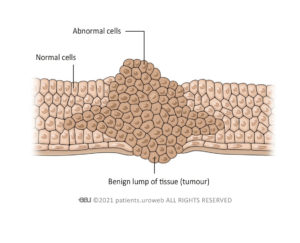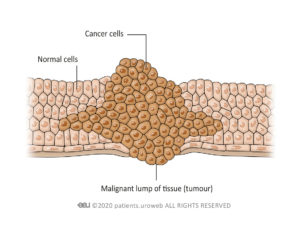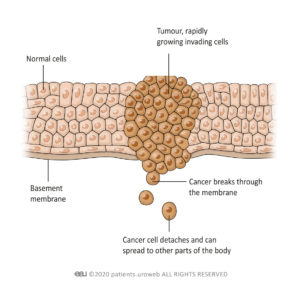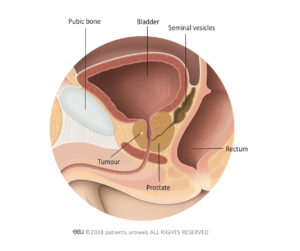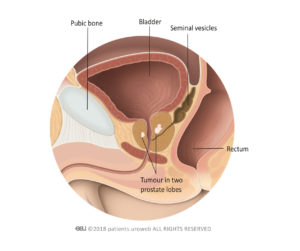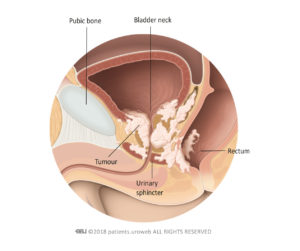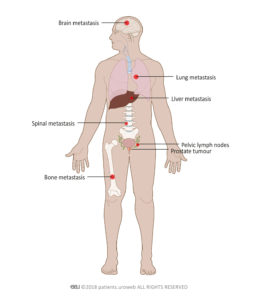What is prostate cancer?
Our bodies are made up of trillions of tiny cells, which are the basic building blocks of all living things. Cells continuously divide to make new cells. It is how we grow and how the body heals itself.
Sometimes a cell becomes abnormal. It is not fully understood why this happens, but when abnormal cells keep dividing and make more and more abnormal cells, eventually a lump of tissue forms, called a tumour.
Not all tumours are cancerous. Benign means the tumour is not cancer, but it might still grow in size. Malignant means the tumour is cancer. Some malignant tumours grow very fast, while others grow much more slowly. If a malignant tumour is left untreated, it may spread to other parts of the body. This spreading of cancer cells is called metastasis.
For detailed cancer information, take a look at our About Cancer page.
Prostate cancer means there are cancer cells inside the prostate that have formed a malignant tumour. If you have recently been diagnosed with prostate cancer, you are not alone. Prostate cancer is the most common cancer among men in Europe, but there are treatment options.
What causes prostate cancer?
The exact cause of prostate cancer is unknown. But certain things increase a man’s chance of developing it. These are called risk factors. Having a risk factor for cancer does not mean a man will get prostate cancer; it just means he has an increased risk.
What are the stages of prostate cancer?
What does localised, locally-advanced, and metastatic mean?
If you have been diagnosed with prostate cancer, you may have heard the terms localised, locally-advanced, or metastatic. All of the different terms can feel overwhelming.
Cancer is often described in stages. These are used to explain the size of the tumour and how far the cancer has spread. Although there are different ways of describing the stage of cancer, one of the simplest ways to understand it is using numbers from 1 to 4.
We have described the stages in their simplest form below.
Understanding stages and cancer terms:
| Stages 1 and 2 | “Early” or “localised” |
| Stages 3 and 4 | “locally-advanced” |
Stage 1:
The tumour is contained or “localised” in the prostate. The cancer is in the very early stages, and the tumour is too small to be felt during a prostate check.
Stage 2:
The tumour is within the prostate. It is still small, but it may be felt during a prostate check and may be visible on a scan. The cancer cells are dividing, and there is an increased risk of the tumour growing and the cancer cells spreading.
Stage 3:
The tumour has started to break through the wall of the prostate, and the cancer cells may be in the nearby tubes that produce semen. This is called “locally-advanced cancer” because the tumour has grown immediately outside the prostate but has not spread to other or “distant” parts of the body.
Stage 4:
The tumour has grown outside the prostate. The cancer cells may be in or around the bladder (such as the bladder neck or urinary sphincter), the back passage (rectum), or in the pelvic floor muscle, which lies underneath the prostate at the base of the pelvis.
Metastatic disease and metastasis
Prostate cancer can spread to the local lymph nodes or bones and even organs such as the liver, lungs, and brain. This spread of cancer cells throughout the body is called “metastasis”, or you may hear it called “metastatic prostate cancer.” When cancer spreads or metastasises to other organs, it is referred to as metastatic disease.
What do grades of cancer mean?
Stages and grades are different. Stages inform your doctor of the size of the tumour and how far the cancer cells have spread. Grades give your doctor an idea of how fast the tumour might grow, and cancer might spread. In general, a lower grade indicates slower-growing cancer, and a higher grade indicates a faster-growing one.
If you have been diagnosed with prostate cancer, your doctor may refer to your “Gleason score” which is a common way of grading prostate cancer. Your Gleason score will help your doctor plan and discuss your treatment options with you.
Your doctor may also refer to an “ISUP grade”. This is another tool used for grading cancer.

